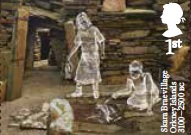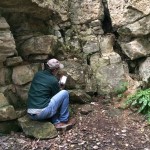 Royal Mail is celebrating Britain’s prehistory with the release on 17 January 2017 of a set of eight commemorative stamps accompanied by presentation materials written by BU’s Professor Timothy Darvill. Four stamps feature well-known prehistoric sites: Skara Brae village in Orkney (3000-2500BC); Avebury henge and stone circles in Wiltshire (c.2500 BC); Grime’s Graves flint mines in Norfolk (c.2500 BC); and Maiden Castle hillfort in Dorset (c.400BC). The other four stamps feature spectacular prehistoric objects: an antler headdress from Star Carr in North Yorkshire (9000BC); the gold cape from Mold in Flintshire (c.1900-1600BC); bronze horns from Drumbest in County Antrim (800BC); and the richly decorated bronze shield from the Thames at Battersea in London (350-50BC). Designed by True North and illustrated by Rebecca Strickson all the images combine aspects of original use with how the sites and objects appear today.
Royal Mail is celebrating Britain’s prehistory with the release on 17 January 2017 of a set of eight commemorative stamps accompanied by presentation materials written by BU’s Professor Timothy Darvill. Four stamps feature well-known prehistoric sites: Skara Brae village in Orkney (3000-2500BC); Avebury henge and stone circles in Wiltshire (c.2500 BC); Grime’s Graves flint mines in Norfolk (c.2500 BC); and Maiden Castle hillfort in Dorset (c.400BC). The other four stamps feature spectacular prehistoric objects: an antler headdress from Star Carr in North Yorkshire (9000BC); the gold cape from Mold in Flintshire (c.1900-1600BC); bronze horns from Drumbest in County Antrim (800BC); and the richly decorated bronze shield from the Thames at Battersea in London (350-50BC). Designed by True North and illustrated by Rebecca Strickson all the images combine aspects of original use with how the sites and objects appear today.
The presentation pack includes an illustrated summary of Britain’s prehistoric past, while the information card accompanying first-day covers and souvenir sets provides brief descriptions of the sites and objects featured on the stamps. Handstamps on first-day covers show a flint arrowhead on the standard cancellation from Edinburgh, and a distinctive archaeological trowel as an alternative postmark linked with Avebury near Marlborough.
Individual stamps can be purchased from Post Offices across the UK, while presentation packs and souvenir issues can be obtained from the Royal Mail on-line shop.
 BU helps celebrate 30 years of World Heritage Sites in the UK
BU helps celebrate 30 years of World Heritage Sites in the UK Building Roman Britain: Project update
Building Roman Britain: Project update Research in post-Brexit Britain “New Neighbours – Old Friends”
Research in post-Brexit Britain “New Neighbours – Old Friends”










 On Christmas Day in the Morning…
On Christmas Day in the Morning… New Nepal scoping review on maternal & neonatal health
New Nepal scoping review on maternal & neonatal health Fourth INRC Symposium: From Clinical Applications to Neuro-Inspired Computation
Fourth INRC Symposium: From Clinical Applications to Neuro-Inspired Computation Writing policy briefs
Writing policy briefs ECR Funding Open Call: Research Culture & Community Grant – Application Deadline Friday 12 December
ECR Funding Open Call: Research Culture & Community Grant – Application Deadline Friday 12 December MSCA Postdoctoral Fellowships 2025 Call
MSCA Postdoctoral Fellowships 2025 Call ERC Advanced Grant 2025 Webinar
ERC Advanced Grant 2025 Webinar Horizon Europe Work Programme 2025 Published
Horizon Europe Work Programme 2025 Published Horizon Europe 2025 Work Programme pre-Published
Horizon Europe 2025 Work Programme pre-Published Update on UKRO services
Update on UKRO services European research project exploring use of ‘virtual twins’ to better manage metabolic associated fatty liver disease
European research project exploring use of ‘virtual twins’ to better manage metabolic associated fatty liver disease